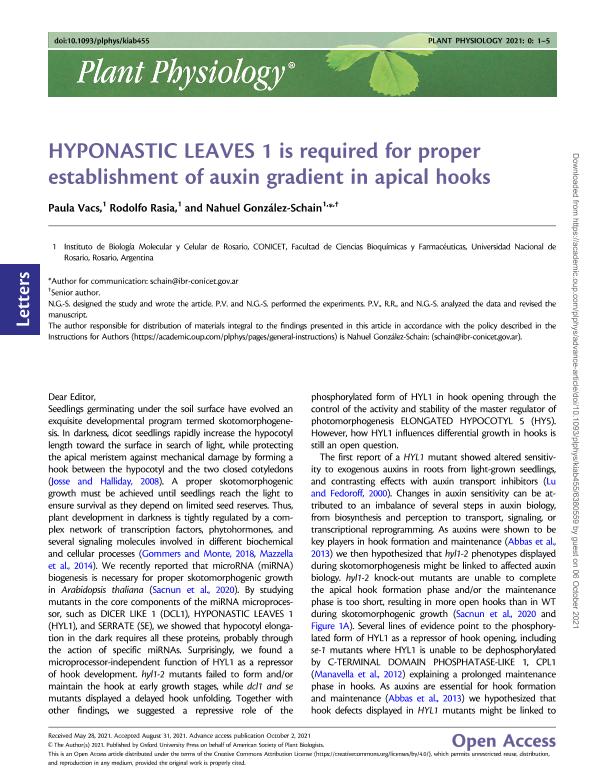Mostrar el registro sencillo del ítem
dc.contributor.author
Vacs, Paula

dc.contributor.author
Rasia, Rodolfo Maximiliano

dc.contributor.author
Gonzalez Schain, Nahuel Damian

dc.date.available
2022-12-27T05:05:46Z
dc.date.issued
2021-10
dc.identifier.citation
Vacs, Paula; Rasia, Rodolfo Maximiliano; Gonzalez Schain, Nahuel Damian; Hyponastic leaves 1 is required for proper establishment of auxin gradient in apical hooks; American Society of Plant Biologist; Plant Physiology; 187; 4; 10-2021; 2356-2360
dc.identifier.issn
0032-0889
dc.identifier.uri
http://hdl.handle.net/11336/182396
dc.description.abstract
Dear Editor,Seedlings germinating under the soil surface have evolved an exquisite developmental program termed skotomorphogenesis. In darkness, dicot seedlings rapidly increase the hypocotyl length toward the surface in search of light, while protecting the apical meristem against mechanical damage by forming a hook between the hypocotyl and the two closed cotyledons (Josse and Halliday, 2008). A proper skotomorphogenic growth must be achieved until seedlings reach the light to ensure survival as they depend on limited seed reserves. Thus, plant development in darkness is tightly regulated by a complex network of transcription factors, phytohormones, and several signaling molecules involved in different biochemical and cellular processes (Gommers and Monte, 2018, Mazzella et al., 2014). We recently reported that microRNA (miRNA) biogenesis is necessary for proper skotomorphogenic growth in Arabidopsis thaliana (Sacnun et al., 2020). By studying mutants in the core components of the miRNA microprocessor, such as DICER LIKE 1 (DCL1), HYPONASTIC LEAVES 1 (HYL1), and SERRATE (SE), we showed that hypocotyl elongation in the dark requires all these proteins, probably through the action of specific miRNAs. Surprisingly, we found a microprocessor-independent function of HYL1 as a repressor of hook development. hyl1-2 mutants failed to form and/or maintain the hook at early growth stages, while dcl1 and se mutants displayed a delayed hook unfolding. Together with other findings, we suggested a repressive role of the phosphorylated form of HYL1 in hook opening through the control of the activity and stability of the master regulator of photomorphogenesis ELONGATED HYPOCOTYL 5 (HY5). However, how HYL1 influences differential growth in hooks is still an open question.
dc.format
application/pdf
dc.language.iso
eng
dc.publisher
American Society of Plant Biologist

dc.rights
info:eu-repo/semantics/openAccess
dc.rights.uri
https://creativecommons.org/licenses/by-nc-sa/2.5/ar/
dc.subject
HYL1
dc.subject
AUXINS
dc.subject
HOOK
dc.subject
SKOTOMORPHOGENESIS
dc.subject.classification
Ciencias de las Plantas, Botánica

dc.subject.classification
Ciencias Biológicas

dc.subject.classification
CIENCIAS NATURALES Y EXACTAS

dc.title
Hyponastic leaves 1 is required for proper establishment of auxin gradient in apical hooks
dc.type
info:eu-repo/semantics/article
dc.type
info:ar-repo/semantics/artículo
dc.type
info:eu-repo/semantics/publishedVersion
dc.date.updated
2022-09-19T16:01:56Z
dc.journal.volume
187
dc.journal.number
4
dc.journal.pagination
2356-2360
dc.journal.pais
Estados Unidos

dc.journal.ciudad
Rockville
dc.description.fil
Fil: Vacs, Paula. Consejo Nacional de Investigaciones Científicas y Técnicas. Centro Científico Tecnológico Conicet - Rosario. Instituto de Biología Molecular y Celular de Rosario. Universidad Nacional de Rosario. Facultad de Ciencias Bioquímicas y Farmacéuticas. Instituto de Biología Molecular y Celular de Rosario; Argentina
dc.description.fil
Fil: Rasia, Rodolfo Maximiliano. Consejo Nacional de Investigaciones Científicas y Técnicas. Centro Científico Tecnológico Conicet - Rosario. Instituto de Biología Molecular y Celular de Rosario. Universidad Nacional de Rosario. Facultad de Ciencias Bioquímicas y Farmacéuticas. Instituto de Biología Molecular y Celular de Rosario; Argentina
dc.description.fil
Fil: Gonzalez Schain, Nahuel Damian. Consejo Nacional de Investigaciones Científicas y Técnicas. Centro Científico Tecnológico Conicet - Rosario. Instituto de Biología Molecular y Celular de Rosario. Universidad Nacional de Rosario. Facultad de Ciencias Bioquímicas y Farmacéuticas. Instituto de Biología Molecular y Celular de Rosario; Argentina
dc.journal.title
Plant Physiology

dc.relation.alternativeid
info:eu-repo/semantics/altIdentifier/url/https://academic.oup.com/plphys/advance-article/doi/10.1093/plphys/kiab455/6380559
dc.relation.alternativeid
info:eu-repo/semantics/altIdentifier/doi/http://dx.doi.org/10.1093/plphys/kiab455
Archivos asociados
